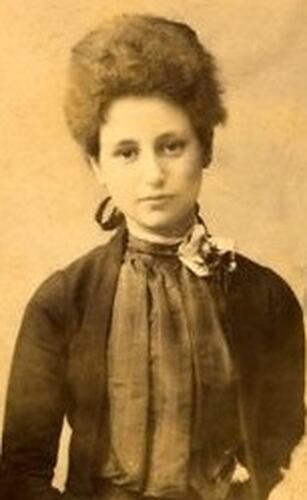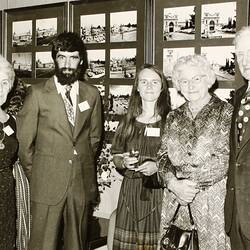May Vale was born on 18 November 1862 in Ballarat, Victoria. She was the second of twelve children of William Mountford Kinsey Vale, stationer, and his wife Rachel, née Lennox, both London born. In 1872 the family moved to Melbourne where May attended Honiton College, St Kilda. During her father's appointment to London in 1874-78 she went to school there and also attended the Royal School of Art in South Kensington. Returning to in Melbourne she studied at the National Gallery schools (1879-86, 1888-89) under G. F. Folingsby and Frederick McCubbin. At Mayfield, originally built for Georgiana McCrae and purchased by William Vale in 1886, May gave her first art lessons.
In 1890 she returned to London and studied under Sir James Linton for two years, then attended the Académie Julian in Paris for six months. On her journey home she painted David Syme's portrait. In 1892 she took a studio in Swanston Street and undertook commissions. In 1895 she moved to Flinders Buildings and set up an art school. Elected a member of the Buonarotti Society in 1883, she was also one of the first two women, the other being landscape artist Jane Sutherland, to be elected to the Council of the Victorian Artists' Society, first in 1900 and again in 1903-04. Vale was also a foundation member (1888) and councillor (1901-02) of the Yarra Sculptors' Society. Some of her major works were illustrated in that society's 1902 exhibition catalogue. That same year she moved to a studio in Elizabeth Street. In 1906 Vale again went to London where she studied enamelling at the Chelsea Polytechnic and attended the Burbeck Institute; she also revisited Paris and the Académie Julian. Her pictures were shown in the Australian Exhibition of Women's Work in 1907 and at the Victorian Artists' Society in 1908. On 20 August 1908 at the registry office in Chelsea, she married Alexander Gilfillan, a mining engineer and friend from her youth, when they had both been members of the Congregational Church.
Arriving once more in Melbourne, she exhibited in 1909 and 1910, and showed her first enamels with the Yarra Sculptors. In an interview published in Southern Sphere (1910) she rightly claimed to be a pioneer of landscape and portraits in enamel, a difficult medium in which she excelled. During World War I she held exhibitions at the Victorian Artists' Society (1915) and Besant Hall (1916) before spending time in New South Wales. She returned to Melbourne in 1917 and exhibited work painted there, mostly small panels of the Illawarra Ranges and the south coast. In 1918 she exhibited for the first time with the Women's Art Club. With the exception of 1922, she exhibited annually throughout the 1920s at the Athenaeum, or in her Oxford Chambers studio where she also held classes. Working in the Australian 'impressionist' tradition, over the next decade she enjoyed painting excursions from her cabin at Diamond Creek. After her husband's death in Singapore in July 1940, May went to live at her brother's house at Black Rock and twice exhibited there during World War II. Although not obtrusive, her personality was vibrant and animated. Pleasant in appearance, with brown hair and eyes, she was robust and independent in attitude. She died on 6 August 1945 at Black Rock and was buried in the Cheltenham cemetery. She is represented in the National Gallery of Victoria, the Art Gallery of New South Wales, and regional galleries at Castlemaine and Warrnambool.
Women, such as May Vale and Jane Sutherland, continued the fight for the professional recognition of women artists.
References:
http://adbonline.anu.edu.au/biogs/A120344b.htm?hilite=may%3Bvale
More Information
-
Keywords
-
Authors
-
Article types

